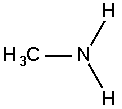Amine
|
|
Amines are organic compounds containing nitrogen as the key atom in the amine functional group. Amines have structures resembling ammonia, where one or more hydrogen atoms are replaced by alkyl groups or other groups where the nitrogen is bonded to a carbon atom in the group (groups symbolized by R below). However, if any of the carbons bonded to the nitrogen is part of a carbonyl group, then the compound is considered an amide rather than an amine.
See the Category:Amines for a list of types of amine and some real examples of this class of chemical.
As shown in the following pictures, if only one the hydrogens in ammonia is replaced by a carbon based group, then it is a primary amine. If two of the hydrogens are replaced by two carbon based groups, then it is a secondary amine. If all three hydrogens are replaced with three carbon based groups, then it is a tertiary amine. Note: the subscripts on the R groups are simply used to label these groups to differentiate them and show that they may be different (or they could be the same). However, the number subscripts on the H atoms show how many H atoms there are in that group.
Primary Amine:
| Secondary Amine: Missing image Amina2.png image:amina2.png | Tertiary Amine: Missing image Amina3.png image:amina3.png |
| Contents [hide] |
Naming
| Lower amines are named with the suffix -amine. | Higher amines have the prefix amino as a functional group.
|
Properties
| Ions of compound | Ka (conjugate acid) |
|---|---|
| Aniline C6H5-NH2 | 2.0·10-5 M |
| Ammonia NH3 | 5.6·10-10 M |
| Ethylene diamine NH2-CH2-CH2-NH2 | 1.3·10-10 M |
| Butylamine CH3-CH2-CH2-CH2-NH2 | 0.15·10-10 M |
Like ammonia, amines act as bases and are reasonably strong (see table for examples of conjugate acid Ka values). The nitrogen atom has a lone electron pair available which can accept a H+ ion to bond to the nitrogen forming a positive substituted ammonium ion. The pairs of dots on the N atoms in the chemical reactions shown in this article represent the lone electron pairs on the nitrogens in the amines. These lone pairs also contribute to the solubility of simple amines due to hydrogen bonding between water molecules and the lone electron pairs.
Amine_to_Ammonium.PNG
Image:Amine_to_Ammonium.PNG
Also, a halogenoalkane can react with an amine to form a corresponding alkyl-substituted amine, with the release of a halogen acid.
Alkylation_of_Amine.PNG
Image:Alkylation_of_Amine.PNG
If the reacting amine is a tertiary amine in such a reaction, then a positive quaternary ammonium cation will be formed along with a negative halide ion.
Formation_of_Quat.PNG
Image:Formation_of_Quat.PNG
These sort of paired ion compounds are called quaternary ammonium salts. The X shown in the above reactions can also be some other leaving group forming a corresponding acid or anion.
A tertiary amine molecule whose substituents are distinct is a chiral object: the nitrogen has four distinct substituents (counting the lone pair) with no plane of symmetry. However, the energetic barrier for the inversion of the stereocenter is very low. As a result, interconversion of the stereoisomers is rapid and isolating stereospecific amines is very difficult. The effect has been compared to the inversion of an open umbrella due to a strong wind.
Inversion_of_Amine.PNG
Image:Inversion_of_Amine.PNG
The volatile amines often have fishy smells.
Synthesis
Primary amines can be synthesized from ammonia and alkyl halides by the Gabriel Synthesis.
Reactions
- Dissolving secondary and tertiary amines using strong acids like HI, HBr, or HCl does not lead to a lower grade amine and an alkylhalide, hence the nitrogen-group is not a preferred leaving group.
- The only kind of successful elimination is the elimination of an alkyl-group from quaternary ammonium salts, the so called Hofmann Elimination
- Because they are basic, amines can neutralize carboxylic acids to form the corresponding substituted ammonium carboxylate salts. Upon heating to 200o C, these salts will dehydrate to form amides, if the initial amine was primary or secondary.
Amine_plus_Carboxylic_Acid.PNG
Image:Amine_plus_Carboxylic_Acid.PNG
- Derivatives of carboxylic acids, such as acyl chlorides, can react with primary or secondary amines to form amides.
Aromatic amines
Aromatic amines are amines in which the nitrogen is connected to an aromatic ring as in anilines. The aromatic ring strongly decreases the basicity of the amine, depending on its substituents. Interestingly, the presence of an amine group strongly increases the reactivity of the aromatic ring, due to an electron-donating affect.
See also
- IUPAC nomenclature for the official naming rules for amines.de:Amine
es:Amina fr:Amine (chimie) he:אמין(כימיה) nl:Amine ja:アミン lv:Amīni pl:Amina pt:Amina sv:Amin vi:Amin zh:胺类



